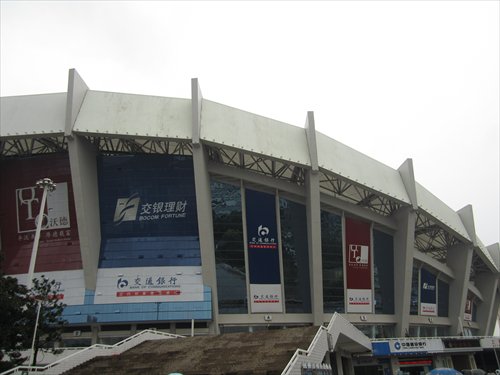Shanghai Swimming Center Station
Top-flight sports venues offer ample options for fitness
Editor's Note:
This year is the 21st anniversary of the opening of the Shanghai metro. The subway has facilitated more than 13 billion journeys during its 21 years, and half of Shanghai citizens cite the metro as their favored mode of transport. To commemorate the anniversary, each week the Global Times will take an in-depth look at one metro station and its surroundings. In the case of downtown stations, we will focus on points of interest within walking distance; while for suburban areas, we will cast our net a little wider.
Located near the commercial zone of Xujiahui, Shanghai Swimming Center Station on metro Line 11 puts passengers in easy reach of a number of popular destinations, including a range of sports facilities and rich dining options.

map
Shanghai Swimming Center
The metro station takes its name from Shanghai Swimming Center (1300 Zhongshannan'er Road, 6438-6902), the multipurpose hexagonal-shaped sports complex that was built in 1983.
The venue houses a standard-size competition pool, a training pool and a diving pool, as well as other sports facilities like a gym, a tennis court, a badminton hall and a table tennis room.
The center is not only a venue for major athletic competitions, but also the main training base for aquatic sports teams in the city. A number of Shanghai-born world swimming champions like Zhuang Yong, Yang Wenyi and Le Jingyi were trained here.
The well-maintained pools are patronized by professional and amateur swimmers alike. Experienced coaches are available to give lessons in areas including swimming, diving, water polo and water ballet. First-time patrons have to buy a 5 yuan ($0.81) health card in the center's foyer and prove they do not have any heart or communicable diseases by having an on-site checkup.
The center charges 20 yuan to 40 yuan for 90 minutes' swimming, including changing time, depending on when you go and subject to an overtime surcharge. Regular customers can buy annual memberships. A shop sells swimming gear on the first floor.
Shanghai Stadium
Shanghai Stadium (666 Tianyaoqiao Road, 6246-6666) is a giant saddle-shaped sports facility built in 1997. Covering an area of 190,000 square meters, it's among the largest stadiums in China.

The saddle-shaped Shanghai Stadium Photos: Yang Fan/GT and CFP
The venue has a capacity of 80,000 and is commonly called the Bawaren Tiyuchang, or 80,000-Seat Stadium, by locals. Large awnings can be spread over the audience stands in case of rain or dazzling sunlight.
The stadium served as a venue for football preliminaries at the Beijing 2008 Olympic Games. It was also used in the opening ceremony of the 2007 Special Olympics World Summer Games, the opening ceremony of China's Eighth National Games, and several sessions of the Shanghai Golden Grand Prix.
The stadium houses an indoor rock climbing center near its No.6 stairway. The center is divided into the practice area, the competition area and an area for rest. Professional coaches are on-site to guide climbers on the wall. Rock climbing equipment, including helmets and ropes, is available for rent.
Other fitness facilities at the stadium include badminton courts, soccer pitches, croquet courts, a rugby pitch and a gym. In addition to playing host to sports games, the stadium also boasts facilities for conferences, exhibitions, fairs and concerts.
Tibetan restaurant
Both well-established upmarket restaurants and wallet-friendly small eateries along the stadium's ring road offer a wide selection for replenishing yourself after a good workout. Among them is Zhaxi Dawa (666 Tianyaoqiao Road, 6426-5576), one of the few Tibetan restaurants in Shanghai. Its Tibetan name means "the propitious moon."
Upon stepping inside, you are struck by the lavishness of the elaborate red-dominated décor.
The first floor is a spacious open hall. Carved wooden artifacts, exquisite thangkas (a kind of Tibetan religious paintings on cotton or silk), and delicate Tibetan jewelry bedeck the walls in tribute to the vast and mysterious roof of the world. The second floor houses four Tibetan-style VIP rooms, each with a poetic name.
With much of the region at high altitude, vegetables are scarce in Tibet, with meats and dairy products forming the staples and being highly prized for their calorific content.
The main ingredients of the restaurant are flown in directly from the Tibetan Plateau to ensure their authentic flavor.
Signature dishes of the restaurant include yak meat, lamb chops, tsampa (roasted barley flour mixed with butter), buttered tea (a Tibetan drink made from yak butter, salt and tea leaves), and homemade yoghurt.
The air-dried beef and mutton is also worth a try, packing a strong flavor.
Professional Tibetan dancers dressed in local festive costumes put on nightly performances involving rippling Tibetan songs and ebullient Guozhuang dances (a famous folk dance in Tibet). During the performances, they present customers with white hadas (a piece of traditional ceremonial silk used as a greeting gift) to offer their blessings.
A gift shop in the restaurant provides a wide range of Tibetan handicrafts for sale. The restaurant is open from 11 am to 10 pm each day.